Creative Writing: What It Is and Why It Matters
By: Author Paul Jenkins
Posted on Published: January 13, 2023 - Last updated: January 15, 2023
Categories Writing
Writing can be intimidating for many people, but creative writing doesn’t have to be. Creative writing is a form of self-expression that allows writers to create stories, characters, and unique settings. But what exactly is creative writing? And why is it important in today’s society? Let’s explore this further.

How We Define Creative Writing
Creative writing is any form where writers can express their thoughts and feelings imaginatively. This type of writing allows authors to draw on their imagination when creating stories and characters and play with language and structure. While there are no boundaries in creative writing, most pieces will contain dialogue, description, and narrative elements.
The Importance of Creative Writing
Creative writing is important because:
- It helps us express ourselves in ways we may not be able to do with other forms of communication.
- It allows us to explore our creativity and think outside the box.
- It can help us better understand our emotions by exploring them through storytelling or poetry.
- Writing creatively can also provide much-needed escapism from everyday life, allowing us to escape into a world of our creation.
- Creative writing helps us connect with others by sharing our experiences through stories or poems they can relate to. This way, we can gain insight into other people’s lives while giving them insight into ours.
Creative Writing: A Path to Mental and Emotional Wellness
Writing is more than just a way to express your thoughts on paper. It’s a powerful tool that can be used as a form of therapy. Creative writing has been shown to improve emotional and mental well-being.
Through creative writing, we can gain insight into our emotions, develop self-expression and communication skills, cultivate empathy and understanding of others, and boost our imagination and creativity.
Let’s examine how creative writing can relieve stress and emotional catharsis.
Stress Relief and Emotional Catharsis
Writing has the power to reduce stress levels significantly. Writing about our experiences or about things that are causing us anxiety or distress helps us to release those complicated feelings constructively. By expressing ourselves through creative writing, we can work through the emotions associated with stressful situations without having to confront them directly.
This is especially helpful for people who struggle to share their emotions verbally or in person.
Improved Communication and Self-Expression
Creative writing is also beneficial for improving communication skills. Through creative writing, we can explore our thoughts and feelings more intensely than by speaking them aloud. This allows us to think more clearly about what we want to say before actually saying it out loud or in written form, which leads to improved self-expression overall.
Additionally, writing out our thoughts before speaking aloud allows us to articulate ourselves better when communicating with others—which is essential for healthy personal and professional relationships.
Increased Empathy and Understanding of Others
Through creative writing, we can also increase our empathy towards others by exploring different perspectives on various topics that may be unfamiliar or uncomfortable for us—such as racism, homophobia, sexism, etc.—and allowing ourselves the opportunity to see the situation from someone else’s point of view without judgment or bias. This helps us become better communicators and more understanding individuals overall.
The Professional Benefits of Creative Writing
Creative writing is a powerful tool that can help you communicate better and more effectively in the professional world. It can also help you develop various skills that prove invaluable in many industries. Whether you’re looking to build your résumé or improve your communication, creative writing can effectively achieve both.
Let’s take a closer look at how creative writing can benefit your career.
Preparing Students for Careers in Writing, Editing, and Publishing
Creative writing is the perfect foundation for anyone interested in pursuing a career in writing, editing, or publishing. It teaches students the basics of grammar and composition while allowing them to express their ideas in imaginative ways.
Creative writing classes also allow students to learn from professionals who have experience as editors, agents, and publishers. They can use this knowledge to learn creative writing, refine their craft and gain valuable experience before entering the job market.
Improving Skills in Storytelling and Marketing for Various Careers
Creative writing teaches students to think critically about stories and craft compelling narratives that draw readers in. This skill is precious for those who wish to pursue careers outside traditional writing roles—such as marketing or advertising—where storytelling is key.
People who understand the fundamentals of creative writing will be able to create persuasive copy that resonates with readers and effectively conveys a message.
Enhancing Team Collaboration and Leadership Skills
Creative writing isn’t just about expressing yourself through words; it also provides an opportunity to practice working collaboratively with others on projects. Many creative writing classes require students to work together on group projects, which helps them develop essential teamwork skills such as communication, critical thinking, problem-solving, and creativity.
As they work together on these projects, they will also gain confidence in their ability to lead teams effectively—an invaluable asset no matter what industry they pursue after graduation.
Uncovering the Power of Creative Writing
Creative writing has become an increasingly powerful force in shaping our society. Creative writing has many uses, from preserving cultural heritage to promoting social change.
Preserving Cultural Heritage with Creative Writing
Creative writing has long been used to preserve and share cultural heritage stories. This is done through fictional stories or poetry that explore a particular culture or group’s history, values, and beliefs. By weaving these stories in an engaging way, writers can bring a culture’s history and traditions to life for readers worldwide. This helps bridge cultural gaps by providing insight into what makes each culture unique.
Promoting Social Change & Activism with Creative Writing
Creative writing can also be used for activism and social change. Writers can craft stories that help promote awareness about important issues such as poverty, race relations, gender equality, climate change, and more.
With the power of words, writers can inspire readers to take action on these issues and work towards creating positive change in their communities.
Through creative writing, writers can raise awareness about important topics while fostering empathy toward individuals who may be facing difficult or challenging situations.
Fostering Creativity & Innovation with Creative Writing
Finally, creative writing can foster creativity and innovation in various fields. For example, businesses can use creative copywriting techniques to create compelling content that captures the attention of customers or potential investors.
Aspiring entrepreneurs can use storytelling techniques when pitching their ideas or products to potential partners or investors to make their cases more persuasive and memorable.
By harnessing the power of words through creative writing techniques, businesses can create content that resonates with their target audience while inspiring them to take action on whatever message they’re trying to convey. It often aids the overall creative process.
Frequently Asked Questions
What are the benefits of creative writing.
Creative writing has many benefits, both for the writer and the reader. For the writer, it can be therapeutic, helping them to explore their emotions and better understand themselves. It can also be used as entertainment or communication, allowing them to share their ideas with the world. For the reader, creative writing can provide enjoyment, escapism, and insights into the human condition.
How can I improve my creative writing skills?
There are several ways you can improve your creative writing skills. Firstly, make sure you allow yourself time to write regularly. Use a writing prompt to inspire a short story. Secondly, read as much as you can; great writers are also great readers. Thirdly, experiment with different styles and genres to find one that suits you best. Fourthly, join a writers’ group, writing workshop, or creative writing program to get feedback from other writers. Finally, keep a journal to track your progress and reflect on your work as a creative writer.
What is the importance of imagery in creative writing?
Imagery is an important element of creative writing, as it helps to create a more vivid picture for the reader. By using sensory and descriptive language, writers can transport readers into their stories and help them relate to their characters or themes. Imagery can bring a scene alive with detail and evoke emotion by helping readers create strong visual images in their minds. Furthermore, imagery can help make stories more memorable by giving readers a deeper connection with the characters or setting.
What are the elements of creative writing?
The elements of creative writing include plot, character, dialogue, setting, theme, and point of view. The plot is the structure or main storyline, while the character is the personage involved in this story. Dialogue includes conversations between characters to give insight into their emotions and relationships. Setting refers to the place or time in which a story takes place, while theme explores deeper meanings behind a story’s narrative. Finally, point of view defines how readers experience a story through first-person or third-person omniscient narration.
What’s the difference between creative writing and other types of writing?
The main difference between creative writing and other types of writing is that it allows the writer to create their own story, characters, settings, and themes. Creative writing also encourages writers to be inventive with their style and use descriptive language to evoke emotion or bring stories alive in readers’ minds. Other academic or technical writing types typically involve more research-based information and are usually more objective in their presentation. Additionally, most forms of non-creative writing will have stricter rules regarding grammar, structure, and syntax.
What is the golden rule of creative writing?
The golden rule of creative writing is to show, not tell. It’s the core creative writing skill. When it comes to creative writing, it’s essential to use descriptive language that immerses readers in the story and allows them to experience the events through their emotions and imaginations. This can be done through metaphors, similes, sensory language, and vivid imagery.
How important is creativity in writing?
Creativity is essential in writing as it allows writers to craft a unique story and evoke emotion from the reader. Creativity can bring stories alive with fresh perspectives and exciting plot lines while creating an escape for readers and giving them more profound insights into the human condition. Writers who combine creativity with technical aspects such as grammar, structure, language usage, and flow will create pieces that capture their audience’s attention and provide an enjoyable reading experience.

What is Creative Writing? A Key Piece of the Writer’s Toolbox
Not all writing is the same and there’s a type of writing that has the ability to transport, teach, and inspire others like no other.
Creative writing stands out due to its unique approach and focus on imagination. Here’s how to get started and grow as you explore the broad and beautiful world of creative writing!
What is Creative Writing?
Creative writing is a form of writing that extends beyond the bounds of regular professional, journalistic, academic, or technical forms of literature. It is characterized by its emphasis on narrative craft, character development, and the use of literary tropes or poetic techniques to express ideas in an original and imaginative way.
Creative writing can take on various forms such as:
- short stories
- screenplays
It’s a way for writers to express their thoughts, feelings, and ideas in a creative, often symbolic, way . It’s about using the power of words to transport readers into a world created by the writer.
5 Key Characteristics of Creative Writing
Creative writing is marked by several defining characteristics, each working to create a distinct form of expression:
1. Imagination and Creativity: Creative writing is all about harnessing your creativity and imagination to create an engaging and compelling piece of work. It allows writers to explore different scenarios, characters, and worlds that may not exist in reality.
2. Emotional Engagement: Creative writing often evokes strong emotions in the reader. It aims to make the reader feel something — whether it’s happiness, sorrow, excitement, or fear.
3. Originality: Creative writing values originality. It’s about presenting familiar things in new ways or exploring ideas that are less conventional.
4. Use of Literary Devices: Creative writing frequently employs literary devices such as metaphors, similes, personification, and others to enrich the text and convey meanings in a more subtle, layered manner.
5. Focus on Aesthetics: The beauty of language and the way words flow together is important in creative writing. The aim is to create a piece that’s not just interesting to read, but also beautiful to hear when read aloud.
Remember, creative writing is not just about producing a work of art. It’s also a means of self-expression and a way to share your perspective with the world. Whether you’re considering it as a hobby or contemplating a career in it, understanding the nature and characteristics of creative writing can help you hone your skills and create more engaging pieces .
For more insights into creative writing, check out our articles on creative writing jobs and what you can do with a creative writing degree and is a degree in creative writing worth it .
Styles of Creative Writing
To fully understand creative writing , you must be aware of the various styles involved. Creative writing explores a multitude of genres, each with its own unique characteristics and techniques.
Poetry is a form of creative writing that uses expressive language to evoke emotions and ideas. Poets often employ rhythm, rhyme, and other poetic devices to create pieces that are deeply personal and impactful. Poems can vary greatly in length, style, and subject matter, making this a versatile and dynamic form of creative writing.
Short Stories
Short stories are another common style of creative writing. These are brief narratives that typically revolve around a single event or idea. Despite their length, short stories can provide a powerful punch, using precise language and tight narrative structures to convey a complete story in a limited space.
Novels represent a longer form of narrative creative writing. They usually involve complex plots, multiple characters, and various themes. Writing a novel requires a significant investment of time and effort; however, the result can be a rich and immersive reading experience.
Screenplays
Screenplays are written works intended for the screen, be it television, film, or online platforms. They require a specific format, incorporating dialogue and visual descriptions to guide the production process. Screenwriters must also consider the practical aspects of filmmaking, making this an intricate and specialized form of creative writing.
If you’re interested in this style, understanding creative writing jobs and what you can do with a creative writing degree can provide useful insights.
Writing for the theater is another specialized form of creative writing. Plays, like screenplays, combine dialogue and action, but they also require an understanding of the unique dynamics of the theatrical stage. Playwrights must think about the live audience and the physical space of the theater when crafting their works.
Each of these styles offers unique opportunities for creativity and expression. Whether you’re drawn to the concise power of poetry, the detailed storytelling of novels, or the visual language of screenplays and plays, there’s a form of creative writing that will suit your artistic voice. The key is to explore, experiment, and find the style that resonates with you.
For those looking to spark their creativity, our article on creative writing prompts offers a wealth of ideas to get you started.
Importance of Creative Writing
Understanding what is creative writing involves recognizing its value and significance. Engaging in creative writing can provide numerous benefits – let’s take a closer look.
Developing Creativity and Imagination
Creative writing serves as a fertile ground for nurturing creativity and imagination. It encourages you to think outside the box, explore different perspectives, and create unique and original content. This leads to improved problem-solving skills and a broader worldview , both of which can be beneficial in various aspects of life.
Through creative writing, one can build entire worlds, create characters, and weave complex narratives, all of which are products of a creative mind and vivid imagination. This can be especially beneficial for those seeking creative writing jobs and what you can do with a creative writing degree .
Enhancing Communication Skills
Creative writing can also play a crucial role in honing communication skills. It demands clarity, precision, and a strong command of language. This helps to improve your vocabulary, grammar, and syntax, making it easier to express thoughts and ideas effectively .
Moreover, creative writing encourages empathy as you often need to portray a variety of characters from different backgrounds and perspectives. This leads to a better understanding of people and improved interpersonal communication skills.
Exploring Emotions and Ideas
One of the most profound aspects of creative writing is its ability to provide a safe space for exploring emotions and ideas. It serves as an outlet for thoughts and feelings , allowing you to express yourself in ways that might not be possible in everyday conversation.
Writing can be therapeutic, helping you process complex emotions, navigate difficult life events, and gain insight into your own experiences and perceptions. It can also be a means of self-discovery , helping you to understand yourself and the world around you better.
So, whether you’re a seasoned writer or just starting out, the benefits of creative writing are vast and varied. For those interested in developing their creative writing skills, check out our articles on creative writing prompts and how to teach creative writing . If you’re considering a career in this field, you might find our article on is a degree in creative writing worth it helpful.
4 Steps to Start Creative Writing
Creative writing can seem daunting to beginners, but with the right approach, anyone can start their journey into this creative field. Here are some steps to help you start creative writing .
1. Finding Inspiration
The first step in creative writing is finding inspiration . Inspiration can come from anywhere and anything. Observe the world around you, listen to conversations, explore different cultures, and delve into various topics of interest.
Reading widely can also be a significant source of inspiration. Read different types of books, articles, and blogs. Discover what resonates with you and sparks your imagination.
For structured creative prompts, visit our list of creative writing prompts to get your creative juices flowing.
Editor’s Note : When something excites or interests you, stop and take note – it could be the inspiration for your next creative writing piece.
2. Planning Your Piece
Once you have an idea, the next step is to plan your piece . Start by outlining:
- the main points
Remember, this can serve as a roadmap to guide your writing process. A plan doesn’t have to be rigid. It’s a flexible guideline that can be adjusted as you delve deeper into your writing. The primary purpose is to provide direction and prevent writer’s block.
3. Writing Your First Draft
After planning your piece, you can start writing your first draft . This is where you give life to your ideas and breathe life into your characters.
Don’t worry about making it perfect in the first go. The first draft is about getting your ideas down on paper . You can always refine and polish your work later. And if you don’t have a great place to write that first draft, consider a journal for writing .
4. Editing and Revising Your Work
The final step in the creative writing process is editing and revising your work . This is where you fine-tune your piece, correct grammatical errors, and improve sentence structure and flow.
Editing is also an opportunity to enhance your storytelling . You can add more descriptive details, develop your characters further, and make sure your plot is engaging and coherent.
Remember, writing is a craft that improves with practice . Don’t be discouraged if your first few pieces don’t meet your expectations. Keep writing, keep learning, and most importantly, enjoy the creative process.
For more insights on creative writing, check out our articles on how to teach creative writing or creative writing activities for kids.
Tips to Improve Creative Writing Skills
Understanding what is creative writing is the first step. But how can one improve their creative writing skills? Here are some tips that can help.
Read Widely
Reading is a vital part of becoming a better writer. By immersing oneself in a variety of genres, styles, and authors, one can gain a richer understanding of language and storytelling techniques . Different authors have unique voices and methods of telling stories, which can serve as inspiration for your own work. So, read widely and frequently!
Practice Regularly
Like any skill, creative writing improves with practice. Consistently writing — whether it be daily, weekly, or monthly — helps develop your writing style and voice . Using creative writing prompts can be a fun way to stimulate your imagination and get the words flowing.
Attend Writing Workshops and Courses
Formal education such as workshops and courses can offer structured learning and expert guidance. These can provide invaluable insights into the world of creative writing, from understanding plot development to character creation. If you’re wondering is a degree in creative writing worth it, these classes can also give you a taste of what studying creative writing at a higher level might look like .
Joining Writing Groups and Communities
Being part of a writing community can provide motivation, constructive feedback, and a sense of camaraderie. These groups often hold regular meetings where members share their work and give each other feedback. Plus, it’s a great way to connect with others who share your passion for writing.
Seeking Feedback on Your Work
Feedback is a crucial part of improving as a writer. It offers a fresh perspective on your work, highlighting areas of strength and opportunities for improvement. Whether it’s from a writing group, a mentor, or even friends and family, constructive criticism can help refine your writing .
Start Creative Writing Today!
Remember, becoming a proficient writer takes time and patience. So, don’t be discouraged by initial challenges. Keep writing, keep learning, and most importantly, keep enjoying the process. Who knows, your passion for creative writing might even lead to creative writing jobs and what you can do with a creative writing degree .
Happy writing!
Brooks Manley

Creative Primer is a resource on all things journaling, creativity, and productivity. We’ll help you produce better ideas, get more done, and live a more effective life.
My name is Brooks. I do a ton of journaling, like to think I’m a creative (jury’s out), and spend a lot of time thinking about productivity. I hope these resources and product recommendations serve you well. Reach out if you ever want to chat or let me know about a journal I need to check out!
Here’s my favorite journal for 2024:
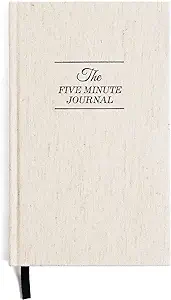
Gratitude Journal Prompts Mindfulness Journal Prompts Journal Prompts for Anxiety Reflective Journal Prompts Healing Journal Prompts Cognitive Behavioral Therapy Journal Prompts Mental Health Journal Prompts ASMR Journal Prompts Manifestation Journal Prompts Self-Care Journal Prompts Morning Journal Prompts Evening Journal Prompts Self-Improvement Journal Prompts Creative Writing Journal Prompts Dream Journal Prompts Relationship Journal Prompts "What If" Journal Prompts New Year Journal Prompts Shadow Work Journal Prompts Journal Prompts for Overcoming Fear Journal Prompts for Dealing with Loss Journal Prompts for Discerning and Decision Making Travel Journal Prompts Fun Journal Prompts
Inspiring Ink: Expert Tips on How to Teach Creative Writing
You may also like, which side of the brain is responsible for creativity.
What is a Flow State and How to Enter it?
47 mental health journal prompts, leave a reply cancel reply.
Save my name, email, and website in this browser for the next time I comment.
- Productivity
- Favorite Journals

Why learn creative writing? Truthfully, creative writing is one of the most misunderstood disciplines in the 21st century. When people think of a creative writing course, they often imagine a group of lofty, out-of-touch people who wear argyle sweater vests and have unproductive conversations about abstract concepts.
In reality, nothing could be further from the truth: the best writing classes remain engaged with the real world, and the skills gained in a creative writing course apply to nearly every facet of daily life.
If you’re wondering whether it’s worth picking up a course in fiction, nonfiction, or poetry, we have five reasons to learn creative writing. But first, let’s talk about what actually happens in a creative writing course.
The Basics of a Writing Workshop
Whether you’re enrolled in a poetry, fiction, or nonfiction writing class, you can expect the following writing process – at least in a quality writing course like the ones at Writers.com.
- Weekly prompts and writing exercises to sharpen the precision and necessity of each word you use.
- Constructive critiques from a community of writers who are each growing their writing skills alongside you.
- A creative space to explore new ideas, experiment with language, and arrange words in new and exciting ways.
- Focused writing instruction from a master of the craft.
The benefits of creative writing come from engaging with the course material, the writing prompts, and the other class members. These elements help you become a better writer, both in creative realms and in everyday life. How? No matter what form of writing, a creative writing class pushes you to connect ideas and create effective narratives using the best words – and that skill translates into real world success.
The Benefits of Creative Writing
1. why learn creative writing: improved self-expression.
Improving your writing skills leads to stronger communication. When you practice finding the right word in a story or poem, you engage the same parts of your brain that are active in everyday writing and speaking. A creative writing course subconsciously turns you into a more effective communicator.
The importance of precise language and self-advocacy translates well into both interpersonal relationships and working environments. Take it from this expert on how writing and self-advocacy results in career and leadership success.
2. Why Learn Creative Writing: Job Success
This brings us to our next point: great writing leads to job success. Of course, your boss probably isn’t expecting you to write emails in the form of a short story or a sonnet – though if they are expecting this, you have a pretty cool boss.
In reality, almost every job requires some sort of written work, whether that’s simple written communication or something more elaborate, like publishing data or marketing materials. In a creative writing class, you practice the style and grammar rules necessary for effective writing, both within the realms of literature and in career-related writing. Sharpening your writing and creativity skills might just land you your next promotion.
3. Why Learn Creative Writing: Improved Thinking Skills
Strong writing leads to strong thinking. No matter what type of writing you pursue, learning how to write is another form of learning how to think.
That might seem like a bold claim, so think about it this way. Without language, our thoughts wouldn’t have form. We might not need language to think “I’m hungry” or “I like cats,” but when it comes to more abstract concepts, language is key. How would you think about things like justice, revenge, or equality without the words to express them?
When you hone in on your ability to find choice, specific words, and when you work on the skills of effective storytelling and rhetoric , you improve your ability to think in general. Good writing yields great thinking!
4. Why Learn Creative Writing: Empathy
Reading and writing both rely on empathy, especially when it comes to being an effective workshop participant. When we read and write stories, we situate ourselves in the shoes of other people; when we read and write poetry, we let language navigate us through emotion.
The importance of creative writing relies on empathy. We practice empathy whenever we listen to another person’s life story, when someone tells us about their day, and when we sit down with a client or work partner. When we write, we practice the ability to listen as well as to speak, making us more effective communicators and more compassionate human beings.
5. Why Learn Creative Writing: It’s Fun!
In case you’re not convinced that a writing course is right for you, let’s clarify one more fact: creative writing is fun. Whether you’re in a fiction writing course, starting a memoir, crafting a poem, or writing for the silver screen, you’re creating new worlds and characters. In the sandbox of literature, you’re in control, and when you invest yourself into the craft of writing, something beautiful emerges.
The Importance of Creative Writing
Simply put, creative writing helps us preserve our humanity. What better medium to explore the human experience?
To learn creative writing, like any art form, requires compassion, contemplation, and curiosity. Writers preserve the world as they observe it in stories and poetry, and they imagine a better world by creating it in their works.
Through the decades, literature has explored society’s profound changes. Literary eons like the Naturalist movement and the Beat poets responded to the increase in Western Industrialization. Confessional poets like Virginia Woolf helped transform poetry into a medium for emotional exploration and excavation. And, genre movements like the cyberpunk writers of science fiction helped popularize the idea of an “information economy.”
Thus, the importance of creative writing lies in its ability to describe the world through an honest and unfiltered lens. Anyone who engages in creative writing, no matter the genre or style, helps us explore the human experience, share new ideas, and advocate for a better society. Whether you write your stories for yourself or share them with a wide audience, creative writing makes the world a better place.
Jobs for Creative Writers
Because creative writing isn’t a STEM discipline, many people don’t think that learning it will help their job prospects. Why learn creative writing if it doesn’t make any money?
In fact, nothing could be further from the truth. Creative writing skills are much sought after on resumes, since both creativity and the ability to write are soft skills in decline. Additionally, if you’re considering a career change—or ready to start one!—these are some popular jobs for creative writers.
- Average Starting Salary: $51,000
- Demand: High
- Skills needed: creativity, grammar, timeliness
Copywriters help companies put their branding into words. A copywriter might write emails, blogs, website content, or ad copy that encompasses the company’s voice and purpose. Copywriting requires you to write in a mix of styles and forms, flexing your writing muscles in new and exciting ways.
Grant Writer
- Average Starting Salary: $50,000
- Skills needed: storytelling, research, argumentation
Nonprofits and research facilities rely on local and national grants to fund their projects. Grant writers help secure that funding, writing engaging grants that tell the organization’s story in an engaging, tailored, and convincing way. Creative writers will enjoy the opportunity to tell a meaningful story and create positive community change through this career.
Communications/Public Relations Specialist
- Skills needed: creativity, communications, social media
A communications specialist helps drive a company’s image through various social channels. They may help create a positive narrative for their company through blogs, journalist outreach, social media, and other public-facing avenues. Much like copywriting, a PR specialist helps weave an effective story for a company.
- Average Starting Salary: $55,000
- Demand: Medium/High
- Skills needed: creativity, storytelling, organization, self-reliance
The dream job for many writers is to write and sell books. Being a novelist is an admirable career choice—and also requires the most work. Not only do you have to write your stories, but you also have to market yourself in the literary industry and maintain a social presence so that publishers and readers actually read your work. It’s a tough business, but also incredibly rewarding!
Reasons to Learn Creative Writing: Finding a Writing Community
Finally, creative writing communities make the writing struggle worth it. The relationships you foster with other creative writers can last a lifetime, as no other group of people has the same appreciation for the written word. Creative writing communities create transformative experiences and encourage growth in your writing; if there’s one reason to study creative writing craft, it’s the friendships you make in the process.
You don’t need a class to start writing, but it’s never a waste of time to learn the tools of the trade. Creative writing requires the skills that can help you in everyday life, and a creative writing course can help.
At Writers.com, we believe that creative writing can transform both individual lives and the world at large. See the importance of creative writing for yourself: check out what makes our creative writing courses different , then take a look at our upcoming course calendar today.
Sean Glatch
Would like to apply for a course to write a novel.
The Real Person!
I’d be happy to help! Please email [email protected] with any questions, and we’ll find the right course for your writing.
[…] Sean. “Why Learn Creative Writing.” writers.com. June 7, 2020. https://writers.com/why-learn-creative-writing . Accessed November 7, […]
[…] And last of all it’s fun! I hope to live my life doing the things I love, with like-minded creative people who I love. I have many exciting things upcoming as I continue with the process of completing my first novel, Les Année Folles, such as publishing to my first magazine, journal, and working on the millions of short story ideas I have stored in my head. Stay tuned! References: Glatch, S. (2020, June 7). WHY LEARN CREATIVE WRITING? Retrieved from Writers.com: https://writers.com/why-learn-creative-writing […]
Leave a Comment Cancel Reply
Save my name, email, and website in this browser for the next time I comment.
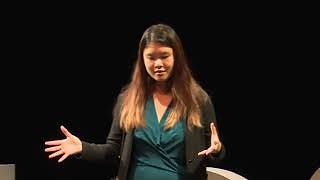
TED is supported by ads and partners 00:00
The Importance of Creative Writing
The benefits of creative writing
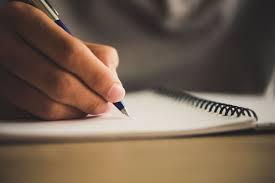
As you learn to clarify your thoughts and emotions more efficiently and accurately, through creative writing, you will communicate more effectively; a skill that’s exceedingly important in all areas of life.
Practising creative writing is about a lot more than just improving your grammar, spelling and vocabulary; it will allow you to develop your own unique voice and share your perspective without limitations, expressing how you feel about the worlds inside and outside of your head. When you engage in creative writing you’re stimulating your imagination and thinking outside the box, which teaches you how to think more innovatively and push boundaries. Both are valuable skills.
Creating a pretend universe will often mean assembling personalities, emotions, and places that might be totally alien to your own life experiences. This is an effective way to build on your capacity to feel empathy and understanding for people who may have had very different life experiences to your own. Your perspectives and philosophies can be mirrored or explored by your characters or their setting. With practise you’ll find yourself becoming more comfortable in asserting your opinions and values in real life.
Expressive writing can bring a range of mental, emotional, and physical health benefits.
If you engage with creative writing when you’re dealing with difficult emotions, it can help you explore why you’re feeling what you’re feeling, allowing a direct insight to your mindset. It’s an opportunity to work through whatever discomfort we’re experiencing so we can get back to whatever we want to achieve today; a healthy way to alleviate the negative thoughts and emotions we experience on a day-to-day basis.
Of course, creative writing exercises can also expand your vocabulary and provide a better understanding of the mechanics of the written word. You’ll learn to distinguish when grammar works and when it doesn’t. With practise, your writing will flow better for the reader.
According to clinical psychologist Karen A.Baikie and psychiatrist Kay Wilhelm, writing creatively about traumatic, stressful or emotional events has been found to improve both physical and psychological health. In a clinical trial, participants who wrote about difficult life events for 20 minutes, on a handful of occasions, had significantly better physical and psychological outcomes compared to those who wrote about neutral topics. Baikie and Wilhelm concluded that expressive writing has real potential as a therapeutic tool for survivors of trauma and in mental health treatment settings.
By Grant J Everett, Panorama magazine
Talk to us today
For more information, contact us on 1300 779 270 or make an enquiry now .
Read all news

Finding Hope and Building Strength with Matt Caruana This Mental Health Month
Every October, Mental Health Month invites us to take a moment to assess our mental health a...
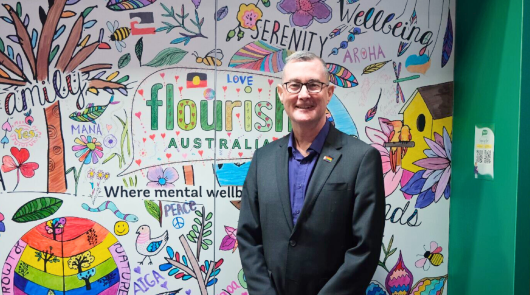
A message from our CEO - September 2024
The arrival of Spring is always a time to be thinking about awakening from the cold of Winte...
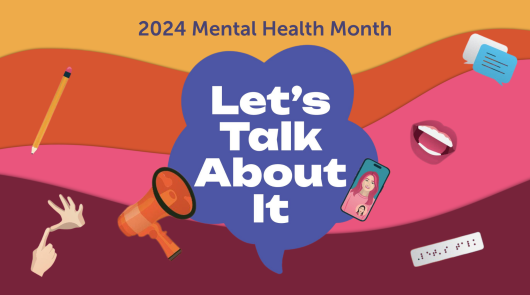
2024 Mental Health Month- Let’s Talk About It
October marks Mental Health Month, an annual event dedicated to raising awa...

What Is Creative Writing? (Ultimate Guide + 20 Examples)
Creative writing begins with a blank page and the courage to fill it with the stories only you can tell.
I face this intimidating blank page daily–and I have for the better part of 20+ years.
In this guide, you’ll learn all the ins and outs of creative writing with tons of examples.
What Is Creative Writing (Long Description)?
Creative Writing is the art of using words to express ideas and emotions in imaginative ways. It encompasses various forms including novels, poetry, and plays, focusing on narrative craft, character development, and the use of literary tropes.

Table of Contents
Let’s expand on that definition a bit.
Creative writing is an art form that transcends traditional literature boundaries.
It includes professional, journalistic, academic, and technical writing. This type of writing emphasizes narrative craft, character development, and literary tropes. It also explores poetry and poetics traditions.
In essence, creative writing lets you express ideas and emotions uniquely and imaginatively.
It’s about the freedom to invent worlds, characters, and stories. These creations evoke a spectrum of emotions in readers.
Creative writing covers fiction, poetry, and everything in between.
It allows writers to express inner thoughts and feelings. Often, it reflects human experiences through a fabricated lens.
Types of Creative Writing
There are many types of creative writing that we need to explain.
Some of the most common types:
- Short stories
- Screenplays
- Flash fiction
- Creative Nonfiction
Short Stories (The Brief Escape)
Short stories are like narrative treasures.
They are compact but impactful, telling a full story within a limited word count. These tales often focus on a single character or a crucial moment.
Short stories are known for their brevity.
They deliver emotion and insight in a concise yet powerful package. This format is ideal for exploring diverse genres, themes, and characters. It leaves a lasting impression on readers.
Example: Emma discovers an old photo of her smiling grandmother. It’s a rarity. Through flashbacks, Emma learns about her grandmother’s wartime love story. She comes to understand her grandmother’s resilience and the value of joy.
Novels (The Long Journey)
Novels are extensive explorations of character, plot, and setting.
They span thousands of words, giving writers the space to create entire worlds. Novels can weave complex stories across various themes and timelines.
The length of a novel allows for deep narrative and character development.
Readers get an immersive experience.
Example: Across the Divide tells of two siblings separated in childhood. They grow up in different cultures. Their reunion highlights the strength of family bonds, despite distance and differences.
Poetry (The Soul’s Language)
Poetry expresses ideas and emotions through rhythm, sound, and word beauty.
It distills emotions and thoughts into verses. Poetry often uses metaphors, similes, and figurative language to reach the reader’s heart and mind.
Poetry ranges from structured forms, like sonnets, to free verse.
The latter breaks away from traditional formats for more expressive thought.
Example: Whispers of Dawn is a poem collection capturing morning’s quiet moments. “First Light” personifies dawn as a painter. It brings colors of hope and renewal to the world.
Plays (The Dramatic Dialogue)
Plays are meant for performance. They bring characters and conflicts to life through dialogue and action.
This format uniquely explores human relationships and societal issues.
Playwrights face the challenge of conveying setting, emotion, and plot through dialogue and directions.
Example: Echoes of Tomorrow is set in a dystopian future. Memories can be bought and sold. It follows siblings on a quest to retrieve their stolen memories. They learn the cost of living in a world where the past has a price.
Screenplays (Cinema’s Blueprint)
Screenplays outline narratives for films and TV shows.
They require an understanding of visual storytelling, pacing, and dialogue. Screenplays must fit film production constraints.
Example: The Last Light is a screenplay for a sci-fi film. Humanity’s survivors on a dying Earth seek a new planet. The story focuses on spacecraft Argo’s crew as they face mission challenges and internal dynamics.
Memoirs (The Personal Journey)
Memoirs provide insight into an author’s life, focusing on personal experiences and emotional journeys.
They differ from autobiographies by concentrating on specific themes or events.
Memoirs invite readers into the author’s world.
They share lessons learned and hardships overcome.
Example: Under the Mango Tree is a memoir by Maria Gomez. It shares her childhood memories in rural Colombia. The mango tree in their yard symbolizes home, growth, and nostalgia. Maria reflects on her journey to a new life in America.
Flash Fiction (The Quick Twist)
Flash fiction tells stories in under 1,000 words.
It’s about crafting compelling narratives concisely. Each word in flash fiction must count, often leading to a twist.
This format captures life’s vivid moments, delivering quick, impactful insights.
Example: The Last Message features an astronaut’s final Earth message as her spacecraft drifts away. In 500 words, it explores isolation, hope, and the desire to connect against all odds.

Creative Nonfiction (The Factual Tale)
Creative nonfiction combines factual accuracy with creative storytelling.
This genre covers real events, people, and places with a twist. It uses descriptive language and narrative arcs to make true stories engaging.
Creative nonfiction includes biographies, essays, and travelogues.
Example: Echoes of Everest follows the author’s Mount Everest climb. It mixes factual details with personal reflections and the history of past climbers. The narrative captures the climb’s beauty and challenges, offering an immersive experience.
Fantasy (The World Beyond)
Fantasy transports readers to magical and mythical worlds.
It explores themes like good vs. evil and heroism in unreal settings. Fantasy requires careful world-building to create believable yet fantastic realms.
Example: The Crystal of Azmar tells of a young girl destined to save her world from darkness. She learns she’s the last sorceress in a forgotten lineage. Her journey involves mastering powers, forming alliances, and uncovering ancient kingdom myths.
Science Fiction (The Future Imagined)
Science fiction delves into futuristic and scientific themes.
It questions the impact of advancements on society and individuals.
Science fiction ranges from speculative to hard sci-fi, focusing on plausible futures.
Example: When the Stars Whisper is set in a future where humanity communicates with distant galaxies. It centers on a scientist who finds an alien message. This discovery prompts a deep look at humanity’s universe role and interstellar communication.
Watch this great video that explores the question, “What is creative writing?” and “How to get started?”:
What Are the 5 Cs of Creative Writing?
The 5 Cs of creative writing are fundamental pillars.
They guide writers to produce compelling and impactful work. These principles—Clarity, Coherence, Conciseness, Creativity, and Consistency—help craft stories that engage and entertain.
They also resonate deeply with readers. Let’s explore each of these critical components.
Clarity makes your writing understandable and accessible.
It involves choosing the right words and constructing clear sentences. Your narrative should be easy to follow.
In creative writing, clarity means conveying complex ideas in a digestible and enjoyable way.
Coherence ensures your writing flows logically.
It’s crucial for maintaining the reader’s interest. Characters should develop believably, and plots should progress logically. This makes the narrative feel cohesive.
Conciseness
Conciseness is about expressing ideas succinctly.
It’s being economical with words and avoiding redundancy. This principle helps maintain pace and tension, engaging readers throughout the story.
Creativity is the heart of creative writing.
It allows writers to invent new worlds and create memorable characters. Creativity involves originality and imagination. It’s seeing the world in unique ways and sharing that vision.
Consistency
Consistency maintains a uniform tone, style, and voice.
It means being faithful to the world you’ve created. Characters should act true to their development. This builds trust with readers, making your story immersive and believable.
Is Creative Writing Easy?
Creative writing is both rewarding and challenging.
Crafting stories from your imagination involves more than just words on a page. It requires discipline and a deep understanding of language and narrative structure.
Exploring complex characters and themes is also key.
Refining and revising your work is crucial for developing your voice.
The ease of creative writing varies. Some find the freedom of expression liberating.
Others struggle with writer’s block or plot development challenges. However, practice and feedback make creative writing more fulfilling.
What Does a Creative Writer Do?
A creative writer weaves narratives that entertain, enlighten, and inspire.
Writers explore both the world they create and the emotions they wish to evoke. Their tasks are diverse, involving more than just writing.
Creative writers develop ideas, research, and plan their stories.
They create characters and outline plots with attention to detail. Drafting and revising their work is a significant part of their process. They strive for the 5 Cs of compelling writing.
Writers engage with the literary community, seeking feedback and participating in workshops.
They may navigate the publishing world with agents and editors.
Creative writers are storytellers, craftsmen, and artists. They bring narratives to life, enriching our lives and expanding our imaginations.
How to Get Started With Creative Writing?
Embarking on a creative writing journey can feel like standing at the edge of a vast and mysterious forest.
The path is not always clear, but the adventure is calling.
Here’s how to take your first steps into the world of creative writing:
- Find a time of day when your mind is most alert and creative.
- Create a comfortable writing space free from distractions.
- Use prompts to spark your imagination. They can be as simple as a word, a phrase, or an image.
- Try writing for 15-20 minutes on a prompt without editing yourself. Let the ideas flow freely.
- Reading is fuel for your writing. Explore various genres and styles.
- Pay attention to how your favorite authors construct their sentences, develop characters, and build their worlds.
- Don’t pressure yourself to write a novel right away. Begin with short stories or poems.
- Small projects can help you hone your skills and boost your confidence.
- Look for writing groups in your area or online. These communities offer support, feedback, and motivation.
- Participating in workshops or classes can also provide valuable insights into your writing.
- Understand that your first draft is just the beginning. Revising your work is where the real magic happens.
- Be open to feedback and willing to rework your pieces.
- Carry a notebook or digital recorder to jot down ideas, observations, and snippets of conversations.
- These notes can be gold mines for future writing projects.
Final Thoughts: What Is Creative Writing?
Creative writing is an invitation to explore the unknown, to give voice to the silenced, and to celebrate the human spirit in all its forms.
Check out these creative writing tools (that I highly recommend):
| Recommended Tools | Learn More |
|---|---|
| Jasper AI | |
| Show Not Tell GPT | |
| Dragon Professional Speech Dictation and Voice Recognition | |
| Surface Laptop | |
| Bluehost | |
| Sqribble (eBook maker) |
Read This Next:
- What Is a Prompt in Writing? (Ultimate Guide + 200 Examples)
- What Is A Personal Account In Writing? (47 Examples)
- How To Write A Fantasy Short Story (Ultimate Guide + Examples)
- How To Write A Fantasy Romance Novel [21 Tips + Examples)
Home › Study Tips › Creative Writing Resources For Secondary School Students
What Is Creative Writing? Is It Worth Studying?
- Published October 31, 2022

As loose as the definition of Creative Writing is, it’s not always easy to understand. Sure, writing a story is Creative Writing. What about poems or personal essays?
Also, how does Creative Writing even help one succeed in university and career life? We empower our Creative Writing summer school students to grasp the power of creative writing and how to use it.
How? By giving them access to personalised tutorials with expert Creative Writing tutors from prestigious universities such as the University of Oxford and Cambridge.
Creative Writing doesn’t have to be confusing or intimidating. In this article, we’ll take you through a simple explanation of what Creative Writing is and why it’s helpful and relevant.
What is Creative Writing?
The simplest description of Creative Writing is what it’s not: it doesn’t revolve around facts like technical writing.
Technical Writing vs Creative Writing
You encounter technical writing in your daily life. You’ll find it in newspapers, journal articles, and textbooks. Do you notice how the presentation of accurate information is necessary in each of these mediums?
Because the goal of technical writing is to explain or relay information as it is .
But in creative writing, such is not the case. The primary goal of Creative Writing is not to present complex information for the sake of educating the audience.
Instead, the goal is to express yourself. Should you want to share information via Creative Writing, the objective becomes persuading your readers to think about it as you do.
Hence, if you contrast Technical Writing and Creative Writing within this context,
- Technical Writing: share information without biases
- Creative Writing: self-expression of how one feels or thinks about said information.
If reducing personal opinion in Technical Writing is virtuous, in creative writing, it is criminal .
Self-Expression in Creative Writing
One must express oneself in Creative Writing to entertain, captivate, or persuade readers. Since Creative Writing involves one’s imagination and self-expression, it’s common for Creative Writers to say that they “poured a part of themselves” into their work.
What are the different ways you can express yourself in Creative Writing?
Types of Creative Writing: 2 Major Types
The two major umbrellas of Creative Writing are Creative Nonfiction and Creative Fiction.
1. Creative Nonfiction
“Nonfiction” means writing based on actual events, persons, and experiences. Some forms of creative nonfiction include:
- Personal Essay – here, the writer shares their personal thoughts, beliefs, or experiences.
- Memoir – captures the writer’s memories and experiences of a life-changing past event.
- Narrative Nonfiction – a factual event written in a story format.
2. Creative Fiction
The bulk of Creative Writing literature is found under the Creative Fiction category, such as:
- Short Story – shorter than a novel, containing only a few scenes and characters.
- Novel – a full-blown plot line with multiple scenes, characters, and subplots.
- Poem – uses specific rhythm and style to express ideas or feelings
- Play – contains dialogue and stage directions for theatre performances.
- Screenplay – script to be used for film production (e.g. movies, video games.)
In short, Creative Fiction involves stories . Do you want more specific examples of Creative Writing? Then, you may want to read this article called “Creative Writing Examples.”
Why Is It Important to Learn Creative Writing?
It’s essential to learn Creative Writing because of the following reasons:
1. Creative Writing is a valuable skill in school and work
As a student, you know well why Creative Writing is important. You submit written work in various situations, such as writing essays for assignments and exams. Or when you have to write a Personal Statement to apply for University.
In these situations, your chances of getting higher grades depend on your ability to write creatively. (Even your chances of getting accepted into a top ranked creative writing university of your dreams!)
What about when you graduate? Do you use Creative Writing in your career? Convincing a recruiter to hire you via cover letters is an example of creative writing.
Once you’re hired, you’ll find that you need to write something up. It depends on your line of work and how often and complex your writing should be.
But mundane tasks such as writing an email response, coming up with a newsletter, or making a PowerPoint presentation involve creative writing.
So when you’ve practised your Creative Writing skills, you’ll find these tasks manageable. Even enjoyable! If you want to study creative writing at university, we put together what a-levels you need for creative writing .
2. Creative Writing enhances several essential skills.
Do you know that writing is thinking? At least that’s what the American Historian and two-time winner of the Pulitzer Prize, David McCullough said.
Many people find Creative Writing challenging because it requires a combination of the following skills:
- Observation
- Critical thinking and analysis
- Reasoning skills
- Communication
Many of these skills make you a valuable employee in many industries. In fact, Forbes reports that:
- Critical Thinking
- and Emotional Intelligence
are three of the Top 10 most in-demand skills for the next decade. That’s why Creative Writing is a valuable endeavour and if you take it at university there are some great creative writing degree career prospects .
3. Creative Writing Is Therapeutic
Do you know that Creative Writing has a significant beneficial effect on your mental and emotional health?
A 2021 study in the Counselling & Psychotherapy Research reports that Creative Writing brought significant health benefits to nine people who worked in creative industries. Writing helped them in their cognitive processing of emotional difficulty.
Result? Improved mood and mental well-being.
A plethora of studies over the decades found the same results. Expressing yourself via creative writing, especially by writing in your daily journal, is beneficial for your mental and emotional health.
4. You may want to work in a Creative Writing-related Career
Creative employment in the UK grows 2x faster than the rest of the economy. In fact, did you know that jobs in the creative industry grew by 30.6% from 2011 to 2018?
Compare that to the average UK growth of 10.1% during the same period, and you can see the potential.
How about in the US? The Bureau of Labor Statistics estimates a 4% increase in employment for authors and writers from 2021 to 2031. Resulting in about 15,200 job openings yearly over the next 10 years.
The median yearly salary? It was at $69,510 as of May 2021.
So if you’re considering a Creative Writing career, now would be a great time to do so!
How To Be A Creative Writer?
You want to be a Creative Writer but don’t know where to start. Don’t worry! The best way to start is to learn from Creative Writing experts .
That’s why we ensure our Creative Writing summer school students have access to 1:1 personalised tutorials with expert Creative Writing tutors.
Our Creative Writing tutors come from world-renowned universities such as the University of Cambridge and Oxford. So you’re in excellent hands!
Here you’ll learn creative writing tips and techniques , such as character creation and plot mapping. But the best part is, you’ll come out of the course having experienced what a Creative Writer is like!
Because by then, you’ll have a Written Portfolio to show for your efforts. Which you presented to your tutor and peers for receiving constructive feedback.
Another surefire way to start becoming a Creative Writer is by practising. Check out this article called “ Creative Writing Exercises .” You’ll begin building a writing routine if you practice these exercises daily.
And trust us, every great writer has a solid writing routine!
Creative Writing is a form of self-expression that allows you to use your imagination and creativity. It can be in the form of personal essays, short stories, or poems. It is often used as an outlet for emotions and experiences. Start with creative writing by reading through creative writing examples to help get you in the mood. Then, just let the words flow daily, and you’re on the road to becoming an excellent Creative Writer!
- I'm a Parent
- I'm a Student
- First Name *
- Last Name *
- Phone number *
- Which subjects interest you? (Optional) Architecture Artificial Intelligence Banking and Finance Biology Biotechnology Business Management Chemistry Coding Computer Science Creative Writing Criminology Economics Encryption and Cybersecurity Engineering English Literature Entrepreneurship Fashion and Design Female Future Leaders Film and Animation Fine and Digital Art Film Studies Global Society and Sustainability History International Relations Law Marketing and Entertainment Mathematics Medicine Medicine and Health Sciences Media and Journalism Nanotechnology Natural Sciences Philosophy Philosophy Politics and Economics Physics Psychology Software Development and AI Software Development and Gaming Veterinary Studies Online Research Programme
Secure priority enrolment for our new summer school location with a small refundable deposit.
" * " indicates required fields
Receive priority enrolment for new summer school locations by registering your interest below.
Our programme consultant will contact you to talk about your options.
- Family Name *
- Phone Number
- Yes. See Privacy Policy.
Subject is unavailable at location
You have selected a subject that is not available at the location that you have previously chosen.
The location filter has been reset, and you are now able to search for all the courses where we offer the subject.

- Onsite training
3,000,000+ delegates
15,000+ clients
1,000+ locations
- KnowledgePass
- Log a ticket
01344203999 Available 24/7

Top 10 Elements of Creative Writing: All you Need to Know
Learn the art of storytelling with our comprehensive blog on the Elements of Creative Writing. Discover the vital components that transform ordinary words into extraordinary tales. Dive into character development, plot intricacies, and more as we cover the core aspects of crafting captivating narratives. Read more to find out!

Exclusive 40% OFF
Training Outcomes Within Your Budget!
We ensure quality, budget-alignment, and timely delivery by our expert instructors.
Share this Resource
- Report Writing Course
- Effective Communication Skills
- Speed Writing Course
- E-mail Etiquette Training
- Interpersonal Skills Training Course

Whether you're an aspiring novelist, a poet, or simply someone who loves to pen down your ideas, understanding the key Elements of Creative Writing can significantly enhance your skills. In this blog, we will explore the top 10 Elements of Creative Writing that are essential for creating compelling and impactful written works, along with tips.
Table of Contents
1) The i mportance of Creative Writing elements
2) Top 10 Elements of Creative Writing
a) Imagery and descriptive language
b) Character development
c) Plot structure
d) Dialogue and conversations
e) Point of View (POV)
f) Setting and world-building
g) Tone and Style
h) Conflict and resolution
i) Theme and symbolism
j) Editing and revision
3) Conclusion
The importance of Creative Writing elements
Creative writing isn't confined to the pages of novels or the lines of poetry; it's a fundamental human expression that predates recorded history. It has been a conduit for cultural preservation, knowledge transfer, and emotional catharsis. But how exactly mastering these elements can improve your writing?
Every art has its tools, and Creative Writing is no different. The elements we'll delve into aren't just guidelines; they're the building blocks that transform your words from ordinary to extraordinary. By understanding and mastering these Creative Writing elements, you'll be equipped to craft narratives that draw readers in, keep them engaged, and leave an indelible mark on their minds and hearts.

Top 10 Elements of Creative Writing
Generally, there are various Elements of Creative Writing, each possessing its own unique features. However, many forms of Creative Writing also share some common features. Here’s a detailed explanation of each element every Writer must follow:
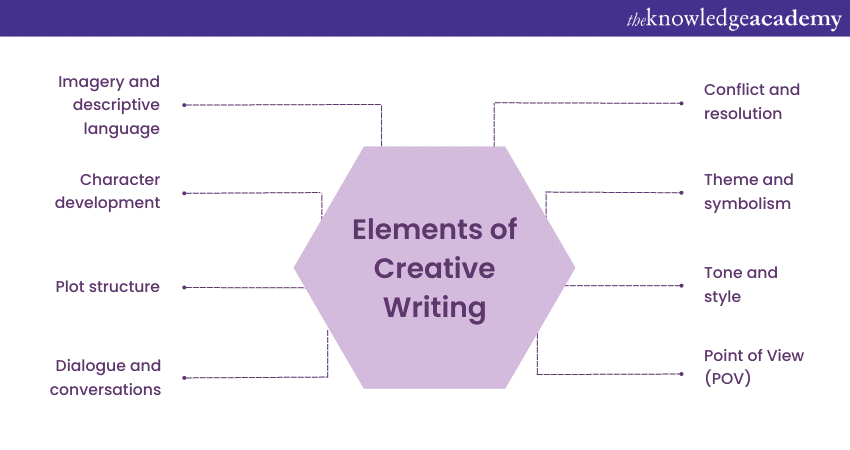
1) Imagery and d escriptive l anguage
Imagery and descriptive language are the brushes with which writers paint vivid mental pictures for their readers. By skillfully weaving sensory details, you bring scenes to life and evoke emotions. The rustling leaves, the scent of freshly baked bread, the gritty texture of sand beneath one's feet—these details create a sensory symphony that immerses readers in your world.
Metaphors, similes, and analogies act as bridges, connecting the familiar with the unfamiliar. Through them, you can compare the indescribable to the known, enriching your narrative with layers of meaning. Mastery of imagery and descriptive language transforms passive reading into an active experience where readers can taste, smell, hear, see, and feel the world you've created.
Tips :
a) When selecting details, focus on the ones that have the most impact and avoid including unnecessary clutter.
b) Use metaphors and similes sparingly, making them truly resonate.
c) T ailor your descriptions to the tone and mood of the scene or story.
2) Character d evelopment
Character development is the art of breathing life into your fictional personas. Well-crafted characters are not only relatable but also complex, with layers of personality, desires, flaws, and history. They drive the plot forward, compelling readers to invest emotionally in their journeys. Backstories provide context, explaining why characters behave the way they do.
Effective character development allows readers to understand, empathise, and even dislike characters. The key lies in making them authentic and evolving. Just as people change, so should your characters. They learn, grow, and adapt, making their arcs believable and satisfying. The beauty of character development is in its ability to mirror the human experience, forging connections between fictional worlds and real hearts.
a) Explore your characters' pasts to understand their motivations and fears.
b) Create a character profile detailing their appearance, background, and personality traits.
c) Show character development through actions and decisions rather than telling.
Unlock your creative potential with our expert-led Creative Writing Training – Register now to ignite your imagination!
3) Plot s tructure
Plot structure is the architecture that holds your narrative together. Think of it as a roller coaster, with highs and lows that keep readers engaged. The introduction sets the stage, introducing characters, settings, and the initial conflict. Rising action builds tension, propelling the story forward. At its peak is the climax, the turning point that determines the characters' fate.
Falling action allows for a gradual untwisting of events, leading to the resolution. Effective plot structure balances pacing, ensuring readers remain intrigued without feeling rushed. Twists and turns add surprise, while cause-and-effect relationships maintain coherence. A well-structured plot keeps readers invested, eagerly flipping pages to discover what happens next.
a) Introduce the main conflict early to hook readers' curiosity.
b) Use cliffhangers and unexpected twists to maintain suspense.
c) Ensure each scene contributes to character development or plot progression.
4) Dialogue and c onversations
Dialogue and conversations are windows into your characters' minds and hearts. Natural and dynamic dialogue conveys information and reveals personalities and relationships. Each character's speech patterns, vocabulary, and tone should be distinct, reflecting their backgrounds and emotions .
Through dialogue, conflicts can be ignited, alliances forged, and secrets unveiled. Subtext—the unspoken thoughts beneath the spoken words—adds depth and intrigue. Conversations can quicken the story's pace, providing relief from dense narrative passages. Dialogue-driven scenes foster engagement, inviting readers to eavesdrop on captivating interactions that fuel the narrative's fire.
a) Listen to real conversations to capture natural rhythms and speech patterns.
b) Use interruptions and nonverbal cues to make dialogue dynamic.
c) Balance dialogue with narrative to avoid overwhelming the reader.
5) Point of View (POV)
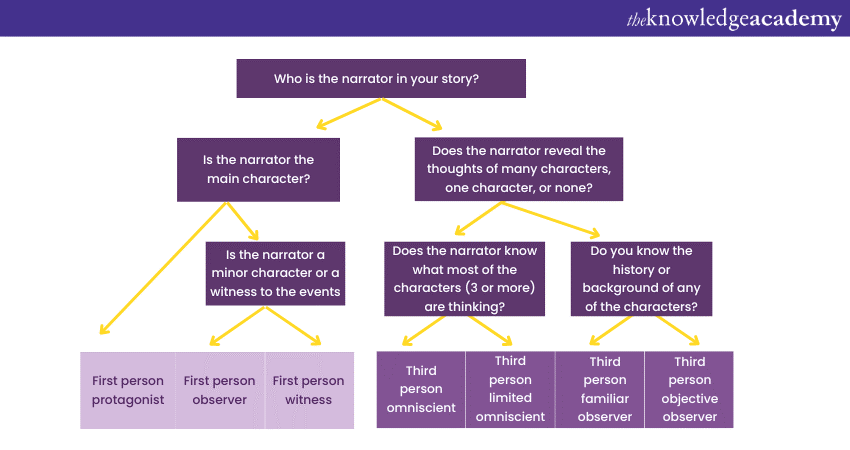
Point of view (POV) is the lens through which your story is perceived. The choice of POV shapes the reader's relationship with characters and events. First-person offers intimacy, allowing readers to see the world through a character's eyes. Second person immerses readers directly into the narrative. Third person limited provides insight into a character's thoughts, while third-person omniscient offers a broader perspective.
Consistency in POV is vital; changing viewpoints can confuse readers. The chosen POV influences what readers know and when they know it. It also affects emotional connection and empathy. Selecting the appropriate POV requires consideration of the story's needs and the desired reader experience.
a) Experiment with different POVs to find the best fit for your story.
b) Consider the level of intimacy and distance you want between characters and readers.
c) Be aware of the limitations and advantages of each POV.
6) Setting and w orld- b uilding
The setting isn't just a backdrop; it's a dynamic element that influences mood and plot. A well-defined setting isn't merely a stage but an active participant, influencing characters and events. You transport readers to a different reality through meticulous detail, allowing them to immerse themselves fully.
Effective world-building extends beyond the physical, encompassing societal norms, rules, and even magic systems in speculative fiction. The environment can reflect themes and impact mood. Whether in a fantasy realm or a contemporary city, the authenticity of the setting enhances the reader's experience.
a) Research settings thoroughly to ensure accuracy and authenticity.
b) Show how characters interact with their environment to convey their experiences.
c) Create a sense of place by using unique and specific details.
7) Tone and style
Tone and style are the fingerprints that make your writing uniquely yours. The tone is the distinctive way you express yourself through words—a combination of tone, diction, and syntax. It reflects your personality as an author. Style encompasses sentence structure, pacing, and word choice, influencing the overall feel of your work .
A comedic style might employ wordplay and witty dialogue, while a dramatic style could use evocative descriptions and emotional introspection. Finding your voice and style involves self-discovery and experimenting with different approaches until you uncover what feels authentic. A strong voice and style leave an indelible mark on readers, making your work instantly recognisable
a) Read more to familiarise yourself with different writing styles.
b) Practice writing in different tones to discover your preferred voice.
c) Revise with a focus on refining your voice; eliminate elements that don't align.
8) Conflict and r esolution
Conflict and resolution are the engine that drives your narrative forward. Conflict introduces challenges that characters must overcome, making their journeys compelling and relatable. There are various types of conflict—internal struggles within characters, external conflicts with other characters or nature, and interpersonal conflicts between characters. Conflict creates tension, propelling the story toward its climax.
The resolution, whether happy or bittersweet, provides closure and offers insights into the characters' growth. Well-crafted conflicts test characters' limits, forcing them to confront their fears, flaws, and desires. Through the resolution, readers witness the transformation and the culmination of the character's arcs.
a) Vary the types of conflict to maintain reader engagement.
b) Build tension gradually; escalate the stakes as the story progresses.
c) Avoid convenient solutions; resolutions should arise from the characters' choices and actions.
Supercharge your writing skills with our Speedwriting Masterclass – Register now and amplify your productivity!
9) Theme and symbolism
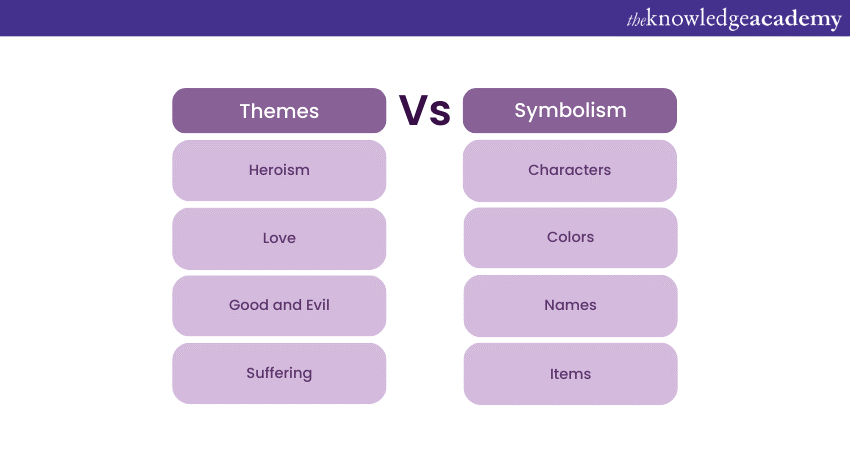
Theme and symbolism lend depth and layers to your writing. Themes are the underlying ideas, beliefs, or messages that resonate with readers. They can explore love, friendship, power, or mortality, connecting the narrative to universal human experiences. Symbolism employs objects, actions, or concepts to convey abstract ideas, often adding an element of intrigue.
A red rose might symbolize love or passion, while a broken mirror could represent self-perception. Themes and symbols intertwine, enriching the story's interpretation and emotional impact. Skilful use of theme and symbolism transforms a tale into an exploration of human nature and society.
Tips:
a) Reflect on the themes that resonate with you and explore them in your writing.
b) Use recurring symbols to reinforce thematic elements.
c) Allow themes to emerge naturally from the characters' struggles and growth.
10) Editing and r evisi on
Editing and revising are the crucial phases that turn your initial draft into a polished masterpiece. Writing is rewriting; the initial draft is a raw exploration of ideas. Editing involves refining sentences for clarity, coherence, and flow. It ensures grammar and punctuation are correct. Revising delves deeper, examining plot holes, character consistency, and thematic resonance.
Seeking feedback from peers or professionals is invaluable, offering fresh perspectives. The revision process is where your story truly comes to life. It's an opportunity to tighten narrative threads, enhance descriptions, and amplify emotions. Embrace the iterative nature of editing and revising; each pass brings your writing closer to its full potential.
a) Revise in multiple passes, focusing on different aspects in each round.
b) Cut unnecessary details or scenes that don't contribute to the narrative.
c) Pay attention to grammar, punctuation, and spelling to ensure a polished final product.
Conclusion
Creative Writing is a journey of discovery, both for the Writer and the reader. In this blog post, we've explored the essential elements that constitute effective Creative Writing. From the foundation of imagination to the nuances of dialogue, style, and conflict, each element plays a pivotal role in crafting a compelling narrative. By mastering these top 10 Elements of Creative Writing, you'll be equipped to create stories that resonate, inspire, and captivate audiences.
Elevate your Copywriting skills to new heights with our Copywriting Masterclass – Join today and craft compelling content that captivates your audience!
Frequently Asked Questions
Upcoming business skills resources batches & dates.
Fri 11th Oct 2024
Fri 13th Dec 2024
Fri 3rd Jan 2025
Fri 7th Mar 2025
Fri 2nd May 2025
Fri 4th Jul 2025
Fri 5th Sep 2025
Fri 7th Nov 2025
Get A Quote
WHO WILL BE FUNDING THE COURSE?
My employer
By submitting your details you agree to be contacted in order to respond to your enquiry
- Business Analysis
- Lean Six Sigma Certification
Share this course
Our biggest summer sale.

We cannot process your enquiry without contacting you, please tick to confirm your consent to us for contacting you about your enquiry.
By submitting your details you agree to be contacted in order to respond to your enquiry.
We may not have the course you’re looking for. If you enquire or give us a call on 01344203999 and speak to our training experts, we may still be able to help with your training requirements.
Or select from our popular topics
- ITIL® Certification
- Scrum Certification
- ISO 9001 Certification
- Change Management Certification
- Microsoft Azure Certification
- Microsoft Excel Courses
- Explore more courses
Press esc to close
Fill out your contact details below and our training experts will be in touch.
Fill out your contact details below
Thank you for your enquiry!
One of our training experts will be in touch shortly to go over your training requirements.
Back to Course Information
Fill out your contact details below so we can get in touch with you regarding your training requirements.
* WHO WILL BE FUNDING THE COURSE?
Preferred Contact Method
No preference
Back to course information
Fill out your training details below
Fill out your training details below so we have a better idea of what your training requirements are.
HOW MANY DELEGATES NEED TRAINING?
HOW DO YOU WANT THE COURSE DELIVERED?
Online Instructor-led
Online Self-paced
WHEN WOULD YOU LIKE TO TAKE THIS COURSE?
Next 2 - 4 months
WHAT IS YOUR REASON FOR ENQUIRING?
Looking for some information
Looking for a discount
I want to book but have questions
One of our training experts will be in touch shortly to go overy your training requirements.
Your privacy & cookies!
Like many websites we use cookies. We care about your data and experience, so to give you the best possible experience using our site, we store a very limited amount of your data. Continuing to use this site or clicking “Accept & close” means that you agree to our use of cookies. Learn more about our privacy policy and cookie policy cookie policy .
We use cookies that are essential for our site to work. Please visit our cookie policy for more information. To accept all cookies click 'Accept & close'.
VIDEO COURSE
Finish your draft in our 3-month master class. Sign up now to watch a free lesson!
Learn How to Write a Novel
Finish your draft in our 3-month master class. Enroll now for daily lessons, weekly critique, and live events. Your first lesson is free!

Guides • Perfecting your Craft
Last updated on Feb 14, 2023
10 Types of Creative Writing (with Examples You’ll Love)
About the author.
Reedsy's editorial team is a diverse group of industry experts devoted to helping authors write and publish beautiful books.
About Savannah Cordova
Savannah is a senior editor with Reedsy and a published writer whose work has appeared on Slate, Kirkus, and BookTrib. Her short fiction has appeared in the Owl Canyon Press anthology, "No Bars and a Dead Battery".
About Rebecca van Laer
Rebecca van Laer is a writer, editor, and the author of two books, including the novella How to Adjust to the Dark. Her work has been featured in literary magazines such as AGNI, Breadcrumbs, and TriQuarterly.
A lot falls under the term ‘creative writing’: poetry, short fiction, plays, novels, personal essays, and songs, to name just a few. By virtue of the creativity that characterizes it, creative writing is an extremely versatile art. So instead of defining what creative writing is , it may be easier to understand what it does by looking at examples that demonstrate the sheer range of styles and genres under its vast umbrella.
To that end, we’ve collected a non-exhaustive list of works across multiple formats that have inspired the writers here at Reedsy. With 20 different works to explore, we hope they will inspire you, too.
People have been writing creatively for almost as long as we have been able to hold pens. Just think of long-form epic poems like The Odyssey or, later, the Cantar de Mio Cid — some of the earliest recorded writings of their kind.
Poetry is also a great place to start if you want to dip your own pen into the inkwell of creative writing. It can be as short or long as you want (you don’t have to write an epic of Homeric proportions), encourages you to build your observation skills, and often speaks from a single point of view .
Here are a few examples:
“Ozymandias” by Percy Bysshe Shelley
Nothing beside remains. Round the decay Of that colossal Wreck, boundless and bare The lone and level sands stretch far away.

This classic poem by Romantic poet Percy Shelley (also known as Mary Shelley’s husband) is all about legacy. What do we leave behind? How will we be remembered? The great king Ozymandias built himself a massive statue, proclaiming his might, but the irony is that his statue doesn’t survive the ravages of time. By framing this poem as told to him by a “traveller from an antique land,” Shelley effectively turns this into a story. Along with the careful use of juxtaposition to create irony, this poem accomplishes a lot in just a few lines.
“Trying to Raise the Dead” by Dorianne Laux
A direction. An object. My love, it needs a place to rest. Say anything. I’m listening. I’m ready to believe. Even lies, I don’t care.
Poetry is cherished for its ability to evoke strong emotions from the reader using very few words which is exactly what Dorianne Laux does in “ Trying to Raise the Dead .” With vivid imagery that underscores the painful yearning of the narrator, she transports us to a private nighttime scene as the narrator sneaks away from a party to pray to someone they’ve lost. We ache for their loss and how badly they want their lost loved one to acknowledge them in some way. It’s truly a masterclass on how writing can be used to portray emotions.
If you find yourself inspired to try out some poetry — and maybe even get it published — check out these poetry layouts that can elevate your verse!
Song Lyrics
Poetry’s closely related cousin, song lyrics are another great way to flex your creative writing muscles. You not only have to find the perfect rhyme scheme but also match it to the rhythm of the music. This can be a great challenge for an experienced poet or the musically inclined.
To see how music can add something extra to your poetry, check out these two examples:
“Hallelujah” by Leonard Cohen
You say I took the name in vain I don't even know the name But if I did, well, really, what's it to ya? There's a blaze of light in every word It doesn't matter which you heard The holy or the broken Hallelujah
Metaphors are commonplace in almost every kind of creative writing, but will often take center stage in shorter works like poetry and songs. At the slightest mention, they invite the listener to bring their emotional or cultural experience to the piece, allowing the writer to express more with fewer words while also giving it a deeper meaning. If a whole song is couched in metaphor, you might even be able to find multiple meanings to it, like in Leonard Cohen’s “ Hallelujah .” While Cohen’s Biblical references create a song that, on the surface, seems like it’s about a struggle with religion, the ambiguity of the lyrics has allowed it to be seen as a song about a complicated romantic relationship.
“I Will Follow You into the Dark” by Death Cab for Cutie
If Heaven and Hell decide that they both are satisfied Illuminate the no's on their vacancy signs If there's no one beside you when your soul embarks Then I'll follow you into the dark
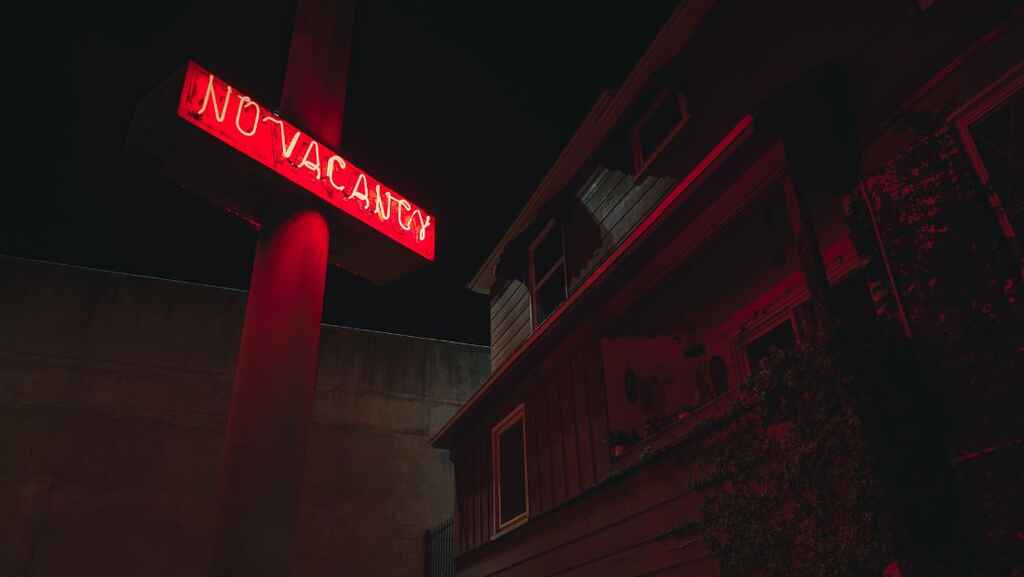
You can think of song lyrics as poetry set to music. They manage to do many of the same things their literary counterparts do — including tugging on your heartstrings. Death Cab for Cutie’s incredibly popular indie rock ballad is about the singer’s deep devotion to his lover. While some might find the song a bit too dark and macabre, its melancholy tune and poignant lyrics remind us that love can endure beyond death.
Plays and Screenplays
From the short form of poetry, we move into the world of drama — also known as the play. This form is as old as the poem, stretching back to the works of ancient Greek playwrights like Sophocles, who adapted the myths of their day into dramatic form. The stage play (and the more modern screenplay) gives the words on the page a literal human voice, bringing life to a story and its characters entirely through dialogue.
Interested to see what that looks like? Take a look at these examples:
All My Sons by Arthur Miller
“I know you're no worse than most men but I thought you were better. I never saw you as a man. I saw you as my father.”

Arthur Miller acts as a bridge between the classic and the new, creating 20th century tragedies that take place in living rooms and backyard instead of royal courts, so we had to include his breakout hit on this list. Set in the backyard of an all-American family in the summer of 1946, this tragedy manages to communicate family tensions in an unimaginable scale, building up to an intense climax reminiscent of classical drama.
💡 Read more about Arthur Miller and classical influences in our breakdown of Freytag’s pyramid .
“Everything is Fine” by Michael Schur ( The Good Place )
“Well, then this system sucks. What...one in a million gets to live in paradise and everyone else is tortured for eternity? Come on! I mean, I wasn't freaking Gandhi, but I was okay. I was a medium person. I should get to spend eternity in a medium place! Like Cincinnati. Everyone who wasn't perfect but wasn't terrible should get to spend eternity in Cincinnati.”
A screenplay, especially a TV pilot, is like a mini-play, but with the extra job of convincing an audience that they want to watch a hundred more episodes of the show. Blending moral philosophy with comedy, The Good Place is a fun hang-out show set in the afterlife that asks some big questions about what it means to be good.
It follows Eleanor Shellstrop, an incredibly imperfect woman from Arizona who wakes up in ‘The Good Place’ and realizes that there’s been a cosmic mixup. Determined not to lose her place in paradise, she recruits her “soulmate,” a former ethics professor, to teach her philosophy with the hope that she can learn to be a good person and keep up her charade of being an upstanding citizen. The pilot does a superb job of setting up the stakes, the story, and the characters, while smuggling in deep philosophical ideas.
Personal essays
Our first foray into nonfiction on this list is the personal essay. As its name suggests, these stories are in some way autobiographical — concerned with the author’s life and experiences. But don’t be fooled by the realistic component. These essays can take any shape or form, from comics to diary entries to recipes and anything else you can imagine. Typically zeroing in on a single issue, they allow you to explore your life and prove that the personal can be universal.
Here are a couple of fantastic examples:
“On Selling Your First Novel After 11 Years” by Min Jin Lee (Literary Hub)
There was so much to learn and practice, but I began to see the prose in verse and the verse in prose. Patterns surfaced in poems, stories, and plays. There was music in sentences and paragraphs. I could hear the silences in a sentence. All this schooling was like getting x-ray vision and animal-like hearing.

This deeply honest personal essay by Pachinko author Min Jin Lee is an account of her eleven-year struggle to publish her first novel . Like all good writing, it is intensely focused on personal emotional details. While grounded in the specifics of the author's personal journey, it embodies an experience that is absolutely universal: that of difficulty and adversity met by eventual success.
“A Cyclist on the English Landscape” by Roff Smith (New York Times)
These images, though, aren’t meant to be about me. They’re meant to represent a cyclist on the landscape, anybody — you, perhaps.
Roff Smith’s gorgeous photo essay for the NYT is a testament to the power of creatively combining visuals with text. Here, photographs of Smith atop a bike are far from simply ornamental. They’re integral to the ruminative mood of the essay, as essential as the writing. Though Smith places his work at the crosscurrents of various aesthetic influences (such as the painter Edward Hopper), what stands out the most in this taciturn, thoughtful piece of writing is his use of the second person to address the reader directly. Suddenly, the writer steps out of the body of the essay and makes eye contact with the reader. The reader is now part of the story as a second character, finally entering the picture.
Short Fiction
The short story is the happy medium of fiction writing. These bite-sized narratives can be devoured in a single sitting and still leave you reeling. Sometimes viewed as a stepping stone to novel writing, that couldn’t be further from the truth. Short story writing is an art all its own. The limited length means every word counts and there’s no better way to see that than with these two examples:
“An MFA Story” by Paul Dalla Rosa (Electric Literature)
At Starbucks, I remembered a reading Zhen had given, a reading organized by the program’s faculty. I had not wanted to go but did. In the bar, he read, "I wrote this in a Starbucks in Shanghai. On the bank of the Huangpu." It wasn’t an aside or introduction. It was two lines of the poem. I was in a Starbucks and I wasn’t writing any poems. I wasn’t writing anything.

This short story is a delightfully metafictional tale about the struggles of being a writer in New York. From paying the bills to facing criticism in a writing workshop and envying more productive writers, Paul Dalla Rosa’s story is a clever satire of the tribulations involved in the writing profession, and all the contradictions embodied by systemic creativity (as famously laid out in Mark McGurl’s The Program Era ). What’s more, this story is an excellent example of something that often happens in creative writing: a writer casting light on the private thoughts or moments of doubt we don’t admit to or openly talk about.
“Flowering Walrus” by Scott Skinner (Reedsy)
I tell him they’d been there a month at least, and he looks concerned. He has my tongue on a tissue paper and is gripping its sides with his pointer and thumb. My tongue has never spent much time outside of my mouth, and I imagine it as a walrus basking in the rays of the dental light. My walrus is not well.
A winner of Reedsy’s weekly Prompts writing contest, ‘ Flowering Walrus ’ is a story that balances the trivial and the serious well. In the pauses between its excellent, natural dialogue , the story manages to scatter the fear and sadness of bad medical news, as the protagonist hides his worries from his wife and daughter. Rich in subtext, these silences grow and resonate with the readers.
Want to give short story writing a go? Give our free course a go!
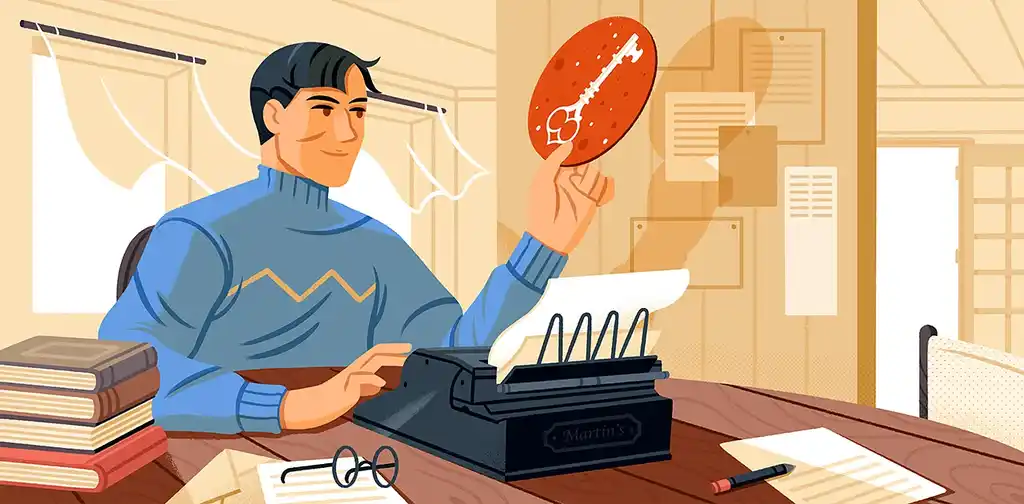
FREE COURSE
How to Craft a Killer Short Story
From pacing to character development, master the elements of short fiction.
Perhaps the thing that first comes to mind when talking about creative writing, novels are a form of fiction that many people know and love but writers sometimes find intimidating. The good news is that novels are nothing but one word put after another, like any other piece of writing, but expanded and put into a flowing narrative. Piece of cake, right?
To get an idea of the format’s breadth of scope, take a look at these two (very different) satirical novels:
Convenience Store Woman by Sayaka Murata
I wished I was back in the convenience store where I was valued as a working member of staff and things weren’t as complicated as this. Once we donned our uniforms, we were all equals regardless of gender, age, or nationality — all simply store workers.
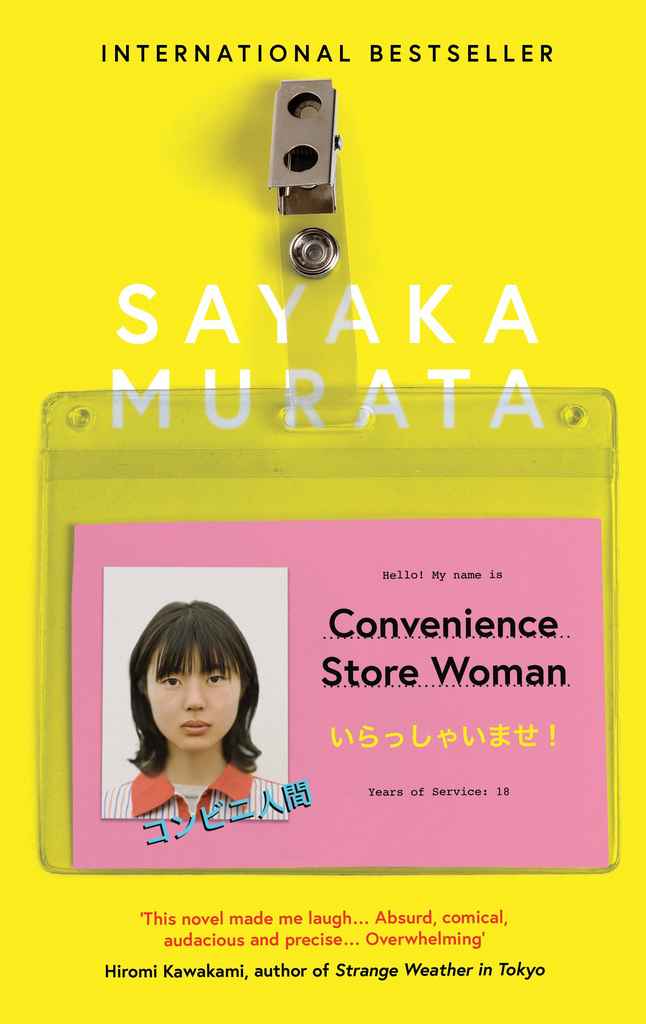
Keiko, a thirty-six-year-old convenience store employee, finds comfort and happiness in the strict, uneventful routine of the shop’s daily operations. A funny, satirical, but simultaneously unnerving examination of the social structures we take for granted, Sayaka Murata’s Convenience Store Woman is deeply original and lingers with the reader long after they’ve put it down.
Erasure by Percival Everett
The hard, gritty truth of the matter is that I hardly ever think about race. Those times when I did think about it a lot I did so because of my guilt for not thinking about it.
Erasure is a truly accomplished satire of the publishing industry’s tendency to essentialize African American authors and their writing. Everett’s protagonist is a writer whose work doesn’t fit with what publishers expect from him — work that describes the “African American experience” — so he writes a parody novel about life in the ghetto. The publishers go crazy for it and, to the protagonist’s horror, it becomes the next big thing. This sophisticated novel is both ironic and tender, leaving its readers with much food for thought.
Creative Nonfiction
Creative nonfiction is pretty broad: it applies to anything that does not claim to be fictional (although the rise of autofiction has definitely blurred the boundaries between fiction and nonfiction). It encompasses everything from personal essays and memoirs to humor writing, and they range in length from blog posts to full-length books. The defining characteristic of this massive genre is that it takes the world or the author’s experience and turns it into a narrative that a reader can follow along with.
Here, we want to focus on novel-length works that dig deep into their respective topics. While very different, these two examples truly show the breadth and depth of possibility of creative nonfiction:
Men We Reaped by Jesmyn Ward
Men’s bodies litter my family history. The pain of the women they left behind pulls them from the beyond, makes them appear as ghosts. In death, they transcend the circumstances of this place that I love and hate all at once and become supernatural.
Writer Jesmyn Ward recounts the deaths of five men from her rural Mississippi community in as many years. In her award-winning memoir , she delves into the lives of the friends and family she lost and tries to find some sense among the tragedy. Working backwards across five years, she questions why this had to happen over and over again, and slowly unveils the long history of racism and poverty that rules rural Black communities. Moving and emotionally raw, Men We Reaped is an indictment of a cruel system and the story of a woman's grief and rage as she tries to navigate it.
Cork Dork by Bianca Bosker
He believed that wine could reshape someone’s life. That’s why he preferred buying bottles to splurging on sweaters. Sweaters were things. Bottles of wine, said Morgan, “are ways that my humanity will be changed.”
In this work of immersive journalism , Bianca Bosker leaves behind her life as a tech journalist to explore the world of wine. Becoming a “cork dork” takes her everywhere from New York’s most refined restaurants to science labs while she learns what it takes to be a sommelier and a true wine obsessive. This funny and entertaining trip through the past and present of wine-making and tasting is sure to leave you better informed and wishing you, too, could leave your life behind for one devoted to wine.
Illustrated Narratives (Comics, graphic novels)
Once relegated to the “funny pages”, the past forty years of comics history have proven it to be a serious medium. Comics have transformed from the early days of Jack Kirby’s superheroes into a medium where almost every genre is represented. Humorous one-shots in the Sunday papers stand alongside illustrated memoirs, horror, fantasy, and just about anything else you can imagine. This type of visual storytelling lets the writer and artist get creative with perspective, tone, and so much more. For two very different, though equally entertaining, examples, check these out:
Calvin & Hobbes by Bill Watterson
"Life is like topography, Hobbes. There are summits of happiness and success, flat stretches of boring routine and valleys of frustration and failure."
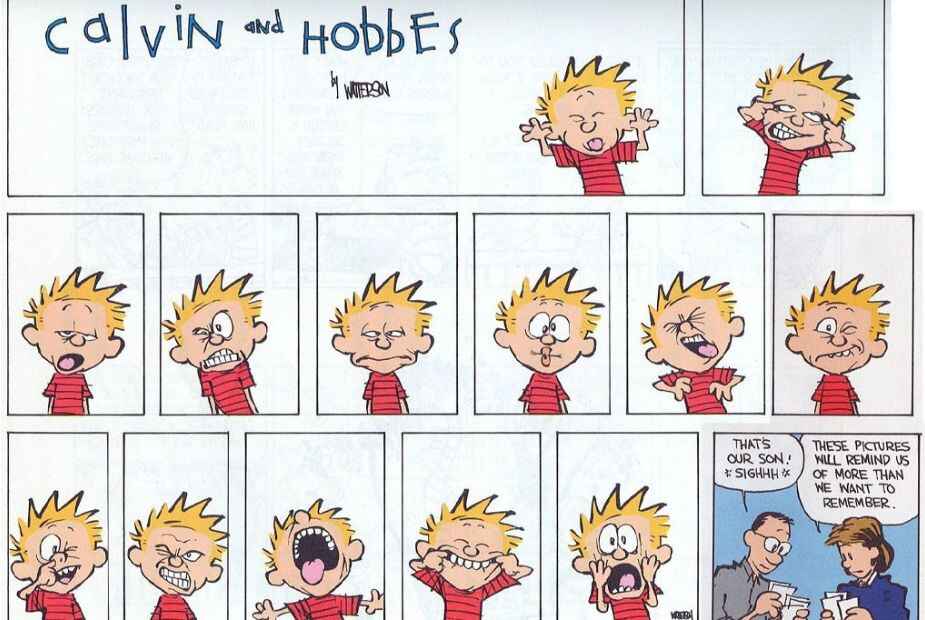
This beloved comic strip follows Calvin, a rambunctious six-year-old boy, and his stuffed tiger/imaginary friend, Hobbes. They get into all kinds of hijinks at school and at home, and muse on the world in the way only a six-year-old and an anthropomorphic tiger can. As laugh-out-loud funny as it is, Calvin & Hobbes ’ popularity persists as much for its whimsy as its use of humor to comment on life, childhood, adulthood, and everything in between.
From Hell by Alan Moore and Eddie Campbell
"I shall tell you where we are. We're in the most extreme and utter region of the human mind. A dim, subconscious underworld. A radiant abyss where men meet themselves. Hell, Netley. We're in Hell."
Comics aren't just the realm of superheroes and one-joke strips, as Alan Moore proves in this serialized graphic novel released between 1989 and 1998. A meticulously researched alternative history of Victorian London’s Ripper killings, this macabre story pulls no punches. Fact and fiction blend into a world where the Royal Family is involved in a dark conspiracy and Freemasons lurk on the sidelines. It’s a surreal mad-cap adventure that’s unsettling in the best way possible.
Video Games and RPGs
Probably the least expected entry on this list, we thought that video games and RPGs also deserved a mention — and some well-earned recognition for the intricate storytelling that goes into creating them.
Essentially gamified adventure stories, without attention to plot, characters, and a narrative arc, these games would lose a lot of their charm, so let’s look at two examples where the creative writing really shines through:
80 Days by inkle studios
"It was a triumph of invention over nature, and will almost certainly disappear into the dust once more in the next fifty years."
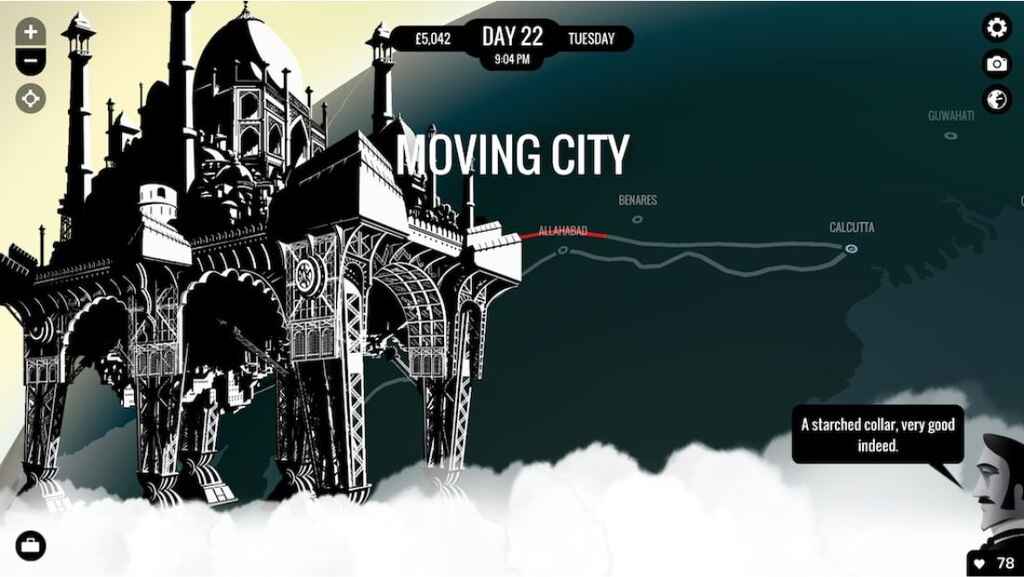
Named Time Magazine ’s game of the year in 2014, this narrative adventure is based on Around the World in 80 Days by Jules Verne. The player is cast as the novel’s narrator, Passpartout, and tasked with circumnavigating the globe in service of their employer, Phileas Fogg. Set in an alternate steampunk Victorian era, the game uses its globe-trotting to comment on the colonialist fantasies inherent in the original novel and its time period. On a storytelling level, the choose-your-own-adventure style means no two players’ journeys will be the same. This innovative approach to a classic novel shows the potential of video games as a storytelling medium, truly making the player part of the story.
What Remains of Edith Finch by Giant Sparrow
"If we lived forever, maybe we'd have time to understand things. But as it is, I think the best we can do is try to open our eyes, and appreciate how strange and brief all of this is."
This video game casts the player as 17-year-old Edith Finch. Returning to her family’s home on an island in the Pacific northwest, Edith explores the vast house and tries to figure out why she’s the only one of her family left alive. The story of each family member is revealed as you make your way through the house, slowly unpacking the tragic fate of the Finches. Eerie and immersive, this first-person exploration game uses the medium to tell a series of truly unique tales.
Fun and breezy on the surface, humor is often recognized as one of the trickiest forms of creative writing. After all, while you can see the artistic value in a piece of prose that you don’t necessarily enjoy, if a joke isn’t funny, you could say that it’s objectively failed.
With that said, it’s far from an impossible task, and many have succeeded in bringing smiles to their readers’ faces through their writing. Here are two examples:
‘How You Hope Your Extended Family Will React When You Explain Your Job to Them’ by Mike Lacher (McSweeney’s Internet Tendency)
“Is it true you don’t have desks?” your grandmother will ask. You will nod again and crack open a can of Country Time Lemonade. “My stars,” she will say, “it must be so wonderful to not have a traditional office and instead share a bistro-esque coworking space.”

Satire and parody make up a whole subgenre of creative writing, and websites like McSweeney’s Internet Tendency and The Onion consistently hit the mark with their parodies of magazine publishing and news media. This particular example finds humor in the divide between traditional family expectations and contemporary, ‘trendy’ work cultures. Playing on the inherent silliness of today’s tech-forward middle-class jobs, this witty piece imagines a scenario where the writer’s family fully understands what they do — and are enthralled to hear more. “‘Now is it true,’ your uncle will whisper, ‘that you’ve got a potential investment from one of the founders of I Can Haz Cheezburger?’”
‘Not a Foodie’ by Hilary Fitzgerald Campbell (Electric Literature)
I’m not a foodie, I never have been, and I know, in my heart, I never will be.
Highlighting what she sees as an unbearable social obsession with food , in this comic Hilary Fitzgerald Campbell takes a hilarious stand against the importance of food. From the writer’s courageous thesis (“I think there are more exciting things to talk about, and focus on in life, than what’s for dinner”) to the amusing appearance of family members and the narrator’s partner, ‘Not a Foodie’ demonstrates that even a seemingly mundane pet peeve can be approached creatively — and even reveal something profound about life.
We hope this list inspires you with your own writing. If there’s one thing you take away from this post, let it be that there is no limit to what you can write about or how you can write about it.
In the next part of this guide, we'll drill down into the fascinating world of creative nonfiction.
Join a community of over 1 million authors
Reedsy is more than just a blog. Become a member today to discover how we can help you publish a beautiful book.

We made a writing app for you
Yes, you! Write. Format. Export for ebook and print. 100% free, always.

1 million authors trust the professionals on Reedsy. Come meet them.
Enter your email or get started with a social account:

IMAGES
COMMENTS
Creative writing is important because: It helps us express ourselves in ways we may not be able to do with other forms of communication. It allows us to explore our creativity and think outside the box. It can help us better understand our emotions by exploring them through storytelling or poetry.
Importance of Creative Writing. Understanding what is creative writing involves recognizing its value and significance. Engaging in creative writing can provide numerous benefits – let’s take a closer look. Developing Creativity and Imagination. Creative writing serves as a fertile ground for nurturing creativity and imagination.
The Importance of Creative Writing. Simply put, creative writing helps us preserve our humanity. What better medium to explore the human experience? To learn creative writing, like any art form, requires compassion, contemplation, and curiosity.
High school writing assignments often err on the side of restrictions, however, she firmly believes that more creative freedom should be offered to students in writing assignments, giving them the freedom to explore their own world and perspective.
Creative writing provides a unique platform for individuals to express themselves freely and authentically. In a world that often stifles emotions and imposes societal expectations, the act of...
Practising creative writing is about a lot more than just improving your grammar, spelling and vocabulary; it will allow you to develop your own unique voice and share your perspective without limitations, expressing how you feel about the worlds inside and outside of your head.
What Is Creative Writing (Long Description)? Creative Writing is the art of using words to express ideas and emotions in imaginative ways. It encompasses various forms including novels, poetry, and plays, focusing on narrative craft, character development, and the use of literary tropes.
Why Is It Important to Learn Creative Writing? It’s essential to learn Creative Writing because of the following reasons: 1. Creative Writing is a valuable skill in school and work. As a student, you know well why Creative Writing is important. You submit written work in various situations, such as writing essays for assignments and exams.
The importance of Creative Writing elements. Creative writing isn't confined to the pages of novels or the lines of poetry; it's a fundamental human expression that predates recorded history. It has been a conduit for cultural preservation, knowledge transfer, and emotional catharsis.
From personal essays and novels to graphic narratives, short stories, and memoirs — here are 10 types of creative writing you might enjoy.